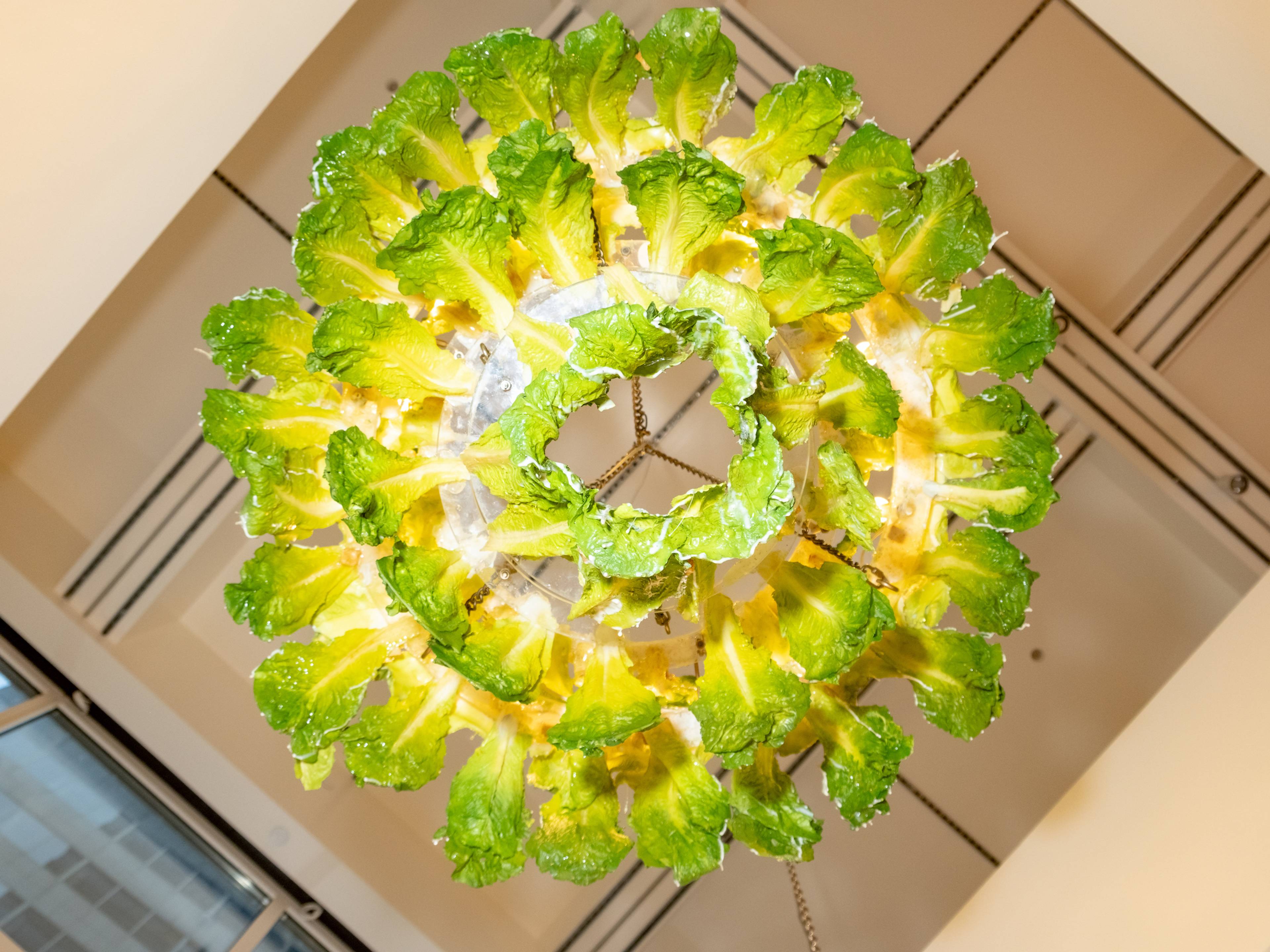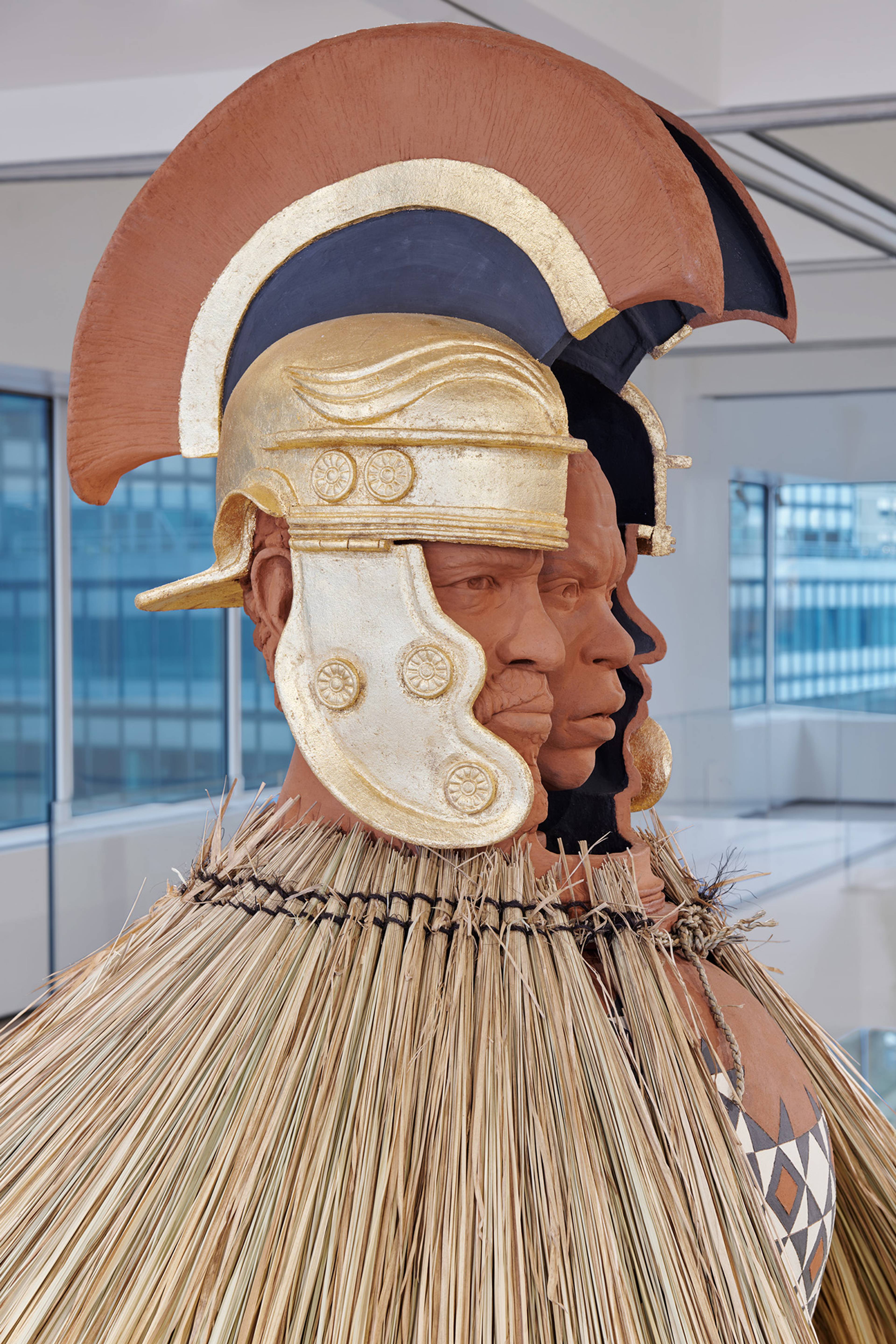First, let me say – I had a great time at dinner.
It was opening night for “YES, CHEF,” an all caps, blue-chip group show produced by influencer-bait real estate venture Water Street Associates in their Wall Street area office tower (formerly an AIG flagship). The party, at the building’s Black Caesar pop-up restaurant, was appropriately swank. At sunset, the 6th-floor windows gave spectacular, salmon-hued views of the New York Seaport, the mast and rigging of some historical schooner overlapping with the cabling of the Brooklyn Bridge. Waitstaff in unlined, buttermilk-colored jackets swanned across the lake of white carpet, delivering family-style portions of overbaked branzino, fluffy harissa lamb sprinkled with barbs of preserved lemon, and brutal little gnocchi stuffed with ricotta and swaddled with cacio e pepe.
Kathleen Ryan, Bad Melon (Moldy Slice), 2020, cherry quartz, rose quartz, agate, amazonite, jasper, aventurine, rhodonite, rhodochrosite, labradorite, smoky quartz, quartz, Botswana agate, carnelian, horn, citrine, glass, cast iron and brass flies, steel and stainless steel pins, polystyrene, aluminum Airstream, 58.5 x 160 x 53.5 cm; Semi-Precious Bone, 2018, freshwater pearls, carved bone, serpentine, sesame jasper, re agate, kiwi jasper, marble, amazonite, onyx, glass and steel pins on plastic-coated foam, 47 x 73 x 44 cm. Installation view, “YES, CHEF,” Water Street Associates, New York, 2024. Photo: Danté Crichlow/BFA.com. © BFA 2024
I had such a great time, actually, that I went back for lunch. (The kitchen, inherited from a previous tenant, will continue to serve limited prix fixe meals and teatime à la carte until the show closes in mid-December.) On a Friday afternoon, unannounced and on my own meager dime, I could focus on the pop-up’s namesake dish: the Black Caesar, a salad of romaine painted with black-garlic dressing and garnished with white anchovies and croutons (“shaved bread”). The sticky, fermented allium put subtle funk on a classic. The romaine, cut crosswise, had space to stretch its legs.
Maybe it was the crisp wine and charming company, but the fine dining outshone the art. The show huddles under a sure-fire theme – food! – so competently that it feels like an advertisement for itself. There’s a big self-portrait by Sara Lucas wearing a raw chicken as a merkin, an Oldenburg-esque giant bag of Café Bustelo coffee by Lucia Hierro, a Jeffrey Meris sculpture comprising clear plastic columns filled with peanuts (hence the allergy warning on the building entrance). Food-shaped resin light fixtures by Chloe Wise include a chandelier resembling a deconstructed Caesar salad, of the kind you might get in an airport.
The notion of a Black Caesar – an African Roman Emperor – inspired dishes that whispered micro-fables of the confluence of Africa and Rome. I won’t say the same for Black Caesar (2024), a sculpture by Tavares Strachan installed near the restaurant’s entrance – a bust of a bearded legionnaire, split open like an Iron Maiden to reveal the shaved terracotta head of a Black stoic. A few of Emperor Septimius Severus’s dying words to his two sons (one of whom would soon murder the other) were printed on cards at the tables: “BE HARMONIOUS / ENRICH THE SOLDIERS / SCORN ALL OTHERS.”
Chloe Wise, Caesar Salad Chandelier, 2021. Installation view, “YES, CHEF,” Water Street Associates, New York, 2024. Photo: Danté Crichlow/BFA.com. © BFA 2024
Tavares Strachan, Black Caesar, 2024, dried rice field, ceramic sculpture, 2.44 x 2.44 m). Installation view, “YES, CHEF,” Water Street Associates, New York, 2024. Photo: Danté Crichlow/BFA.com. © BFA 2024
But it’s caveat emptor where the art’s concerned. The blithe assertion on the wall label that Strachan’s piece “gives form to an invisibilized history and individual” sent me into the sewage-slick online forums about Ancient Rome. I quickly learned (and Strachan must have known, too) that Septimius wasn’t Black in any modern sense. He was part Roman, part Carthaginian, born in present-day Libya. Maybe I’m wrong – and I feel like a conservative tabloid pundit saying this – but the suggestion that the existence of a Black Roman Emperor has been suppressed until now feels like sloppy fabulation.
The cuisine, though! Between fetid swill and mind-blowing creativity, food offers a wide middle of satisfaction and pleasure. And there are few more intimate ways to get to know another person than to share their favorite dishes. Food can unite, or divide; it can be a vehicle for bigotry, or understanding. It can bridge history and contemporaneity. Community, conviviality, joy – in food, these aspirational claims come true. It’s no wonder artists want to be chefs. I kind of want to be a food critic.
Remember when Trump served a championship football team cold McDonald’s at the White House? Remember when he dog-whistled that Haitians are gonna eat your dog? These are powerful ideas – up there with Marina Abramović decorating gala tables with living heads, or Wim Delvoye’s artificial digestive system.
Yet cooking is a politically modest discipline. A bite might change your life, but it won’t change the world.
–
This past 4th of July, I was in Tijuana for the Grand Centenario of the caesar salad.
Tijuana has been a party town at least since Prohibition, when Hollywood types would cross the border for a four-martini dinner then fly back to LA. It was on one such occasion, a US Independence Day fête on 4 July 1924, when an Italian restaurateur named Caesar Cardini ran out of main courses and had to improvise for a group of VIPs. A few coddled eggs, garlic and olive oil, a little Dijon mustard and parmesan cheese in a wooden bowl – toss in Romaine lettuce and garnish with croutons: The Caesar salad was born. Today, among the city’s craft beer pubs and souvenir shops and donkeys painted like zebras, there’s still Caesar’s Restaurant, where haggard ensaladeros whip up the namesake tableside, dozens an hour.
Caesar’s Restaurant, Tijuana
The Caesar is a salad of confluence, of immigrants – and maybe the global appeal of la ensalada mas famosa has to do with its cosmopolitanism. Italian cheese, Mexican limes, a lettuce named for Rome but farmed in California, French condiments, whipped up in Baja by a chef with Continental chops who’d immigrated from Italy by way of San Diego. The story of the Caesar salad is the movements of goods and people and wealth.
With buildings and restaurants, a critic’s job is nakedly to drive or dissuade potential customers. Art criticism, at least these days, has a more oblique relationship to art’s economy.
It was heavy, in the moment – to spend my country’s birthday in their country – while our flashback of an ex-President kept ranting about the purity of “our” country’s blood. Pulses of life, scenes of eerie ruin.
With buildings and restaurants, a critic’s job is nakedly to drive or dissuade potential customers. Art criticism, at least these days, has a more oblique relationship to art’s economy. When I got home after the “YES, CHEF” opening, I wondered why I’d been invited. To inspire favorable press, maybe. (Did they know I love caesar salads?) But the nested experience of exclusive office space, big-name art, and themed dining seemed to solicit another sort of response, like a selfie. Black Caesar the sculpture can’t live up to its political claims, and Black Caesar the restaurant seems depressingly digestible in its company. The food was good. But I left feeling like an ungrateful guest.






